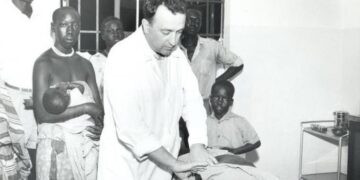By Dr. Miriam Laker-Oketta
She has advanced training in Epidemology and Biostatistcs. Her current research focus is HIV- associated mailgancies, specifically Kaposi’s sarcoma and cervical cancer epidemiology, early detection, diagnosis and treatment. She is also co-founder of the Hub for African Women in Science (AWiSH)
There is an Ebola outbreak in Uganda. Not the first one. Many of us may still recall the outbreak in Gulu, Northern Uganda where several patients and health workers, including the head of St Mary’s Hospital Lacor, Dr. Matthew Lukwiya died in the line of duty. In the month since this new outbreak in western Uganda was declared, the World Health Organization (WHO) reported that by 19 October 2022, there were 64 confirmed cases of the disease with 25 deaths (Case fatality rate: 39%). Among these, at least 11 healthcare workers were infected, of whom five died.
What Ebola is
Ebola is a shortform for Ebola virus disease, formerly known as Ebola haemorrhagic fever. While rare, it is a fatal illness that usually occurs in outbreaks. It is transmitted to people from wild animals and spreads in the human population through human-to-human transmission starting from what in epidemics is called the index piece – the first infected person to spread it to another human. Records from previous outbreaks show that on average, one out of every 2 people who gets infected dies. In worse epidemics, 9 out of every 10 died. In the current epidemic in Uganda, 4 out of 10 have died. The first case of Ebola was reported in 1976 and since then the worst outbreak reported was in West Africa 2014 to 2016.
Ebolavirus is one of three other viruses. The other two are Cuevavirus and Marburgvirus. They are transmitted the same way and cause similar symptoms – fever, headache, muscle pain, weakness, vomiting and diarrhea. The more severe cases can include; damage to blood vessels resulting in extensive internal and external bleeding. Ebola has 5 subtypes/strains, all named after the location they were first detected. They are the Zaire ebolavirus; Sudan virus; Taï Forest virus, formerly Côte d’Ivoire ebolavirus; and Bundibugyo virus. The current epidemic in Uganda is the Sudan virus.
What is different about the Sudan strain
According to the WHO, it is the first time in more than a decade that the Sudan strain has been found in Uganda. In previous outbreaks, deaths from the Sudan strain have ranged from 4 out of every 10 to 100% of cases. The strain does not yet have an effective treatment or vaccination. It is uncertain whether the same vaccine that works for the Zaire strain will work for this strain. There is a vaccine that is being tested but at the moment, it is uncertain if it is working.
Prevention
Infection happens when one gets in contact with blood or body fluids of a person who is sick with or has died from Ebola. Also, contact with objects that have been contaminated with body fluids (like blood, faeces, vomit) from a person sick with Ebola or the body of a person who died from Ebola can cause infection.
Once an epidemic has been determined, the first thing that must be done is to break the chain of infection. As Ebola spreads from person to person, this means limiting interactions of people in the affected geography with other people. Reducing movements within the affected areas is one of the methods that have been shown to work. People must avoid crowded places and restrict as much as possible, their interactions with people outside their daily circle of contact, reducing movements of people out of and into the affected areas. In Uganda so far, the president has imposed a lockdown on the affected districts to keep in and out movements in check.
So far, evidence suggests that people get more infectious as they get sicker. Moreover, corpses are even extremely infectious. Prevention, therefore, requires health workers to carry out the highest level of infection prevention practice including complete coverage of all their body parts using personal protective equipment and sanitizing completely as they get in and out of health facilities and move from one part of the health facility.
In addition, health workers must take extreme care as they take off their protective gear. It is thought that a number of infections in health workers have resulted from accidentally touching for instance their eyes with tainted fingers which can easily happen when one is exhausted from treating people with such a complex disease. There have also been cases where health workers are not wearing completely occlusive gear, infectious fluid from patients made contact with their bodies and led to infections.
In the general population, cultural practices related to death have been known to be prime sources of infection. Many African cultures involve washing and touching the body of the deceased as a sign of love. Ebola prevention requires that no one gets in contact with the corpse. When a person dies of Ebola, health workers fully dressed in the protective gear should put the body into a non-porous plastic bag. If using a coffin, the body should be immediately placed and locked up in it.
The coffin should then be generously sprayed with a potent sanitizer. The burial should take place within a few hours of death since it gets more infectious as time passes. Burial should be conducted by specially trained personnel also donned in protective gear. Funerals should not be crowded events. Families are advised to arrange communal funeral services after the epidemic has been declared ended.
















